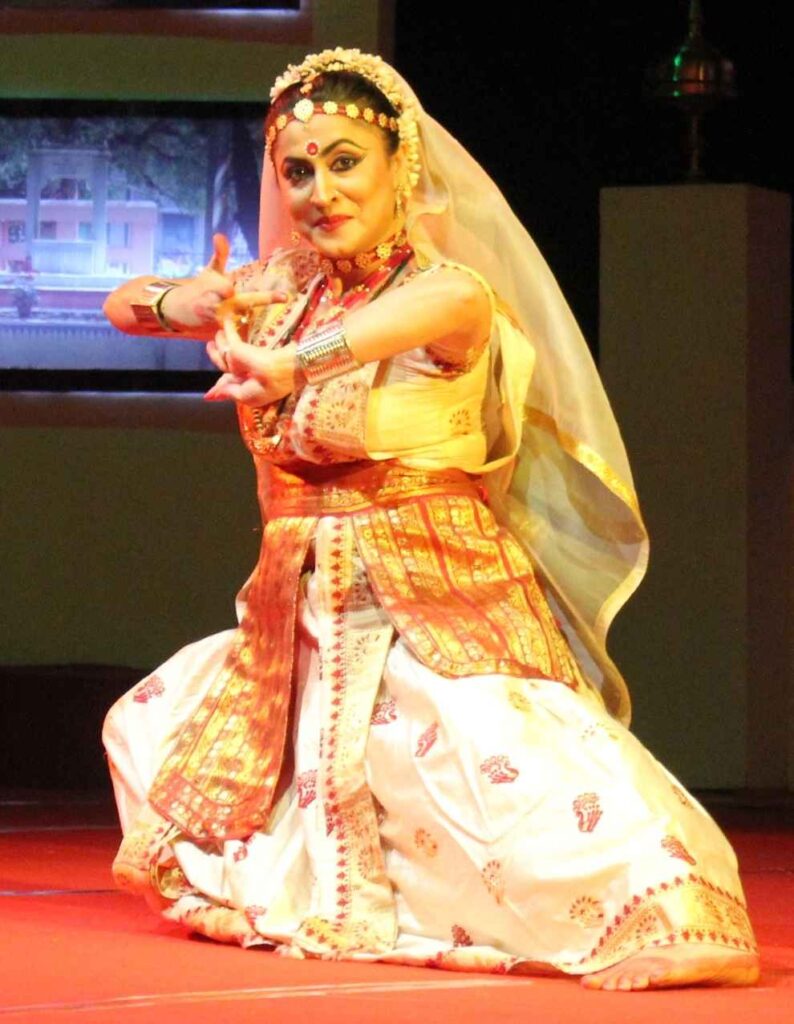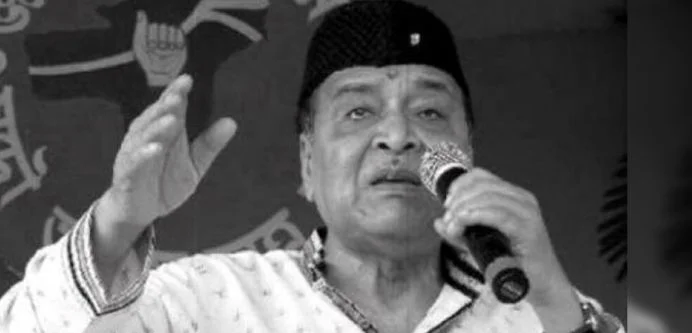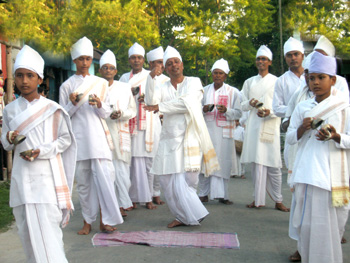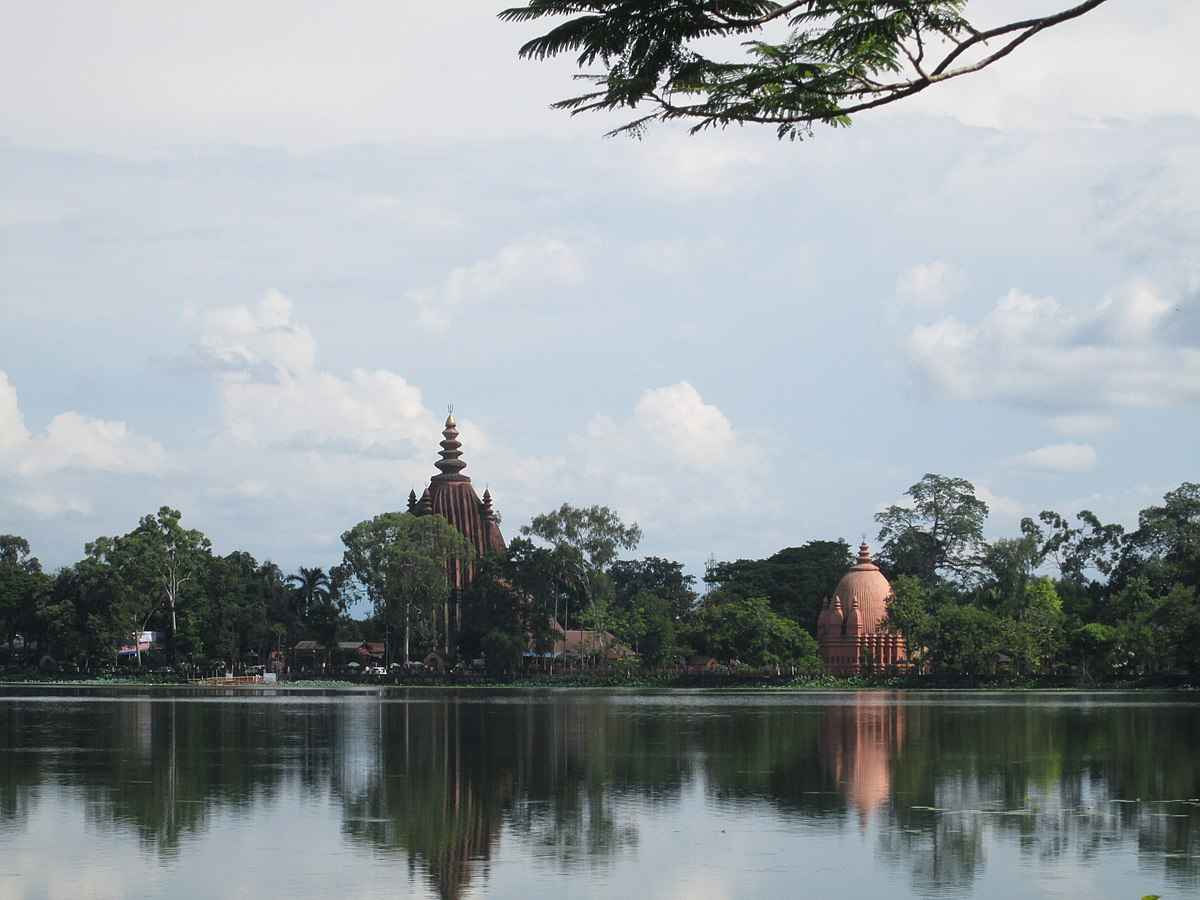Introduction to Sattriya Nritya
Sattriya Nritya, originating in the mystical land of Assam, is a dance form steeped in rich cultural heritage. Here are the key points:
- Origins and Spiritual Roots:
- Founded by the Vaishnava saint Srimanta Sankardev in the 15th century.
- Flourished within the Vaishnavite monasteries (sattras) of Assam.
- Accompanies the Ankia Naata, a one-act drama created by Sankardev.
- Distinctive Features:
- Male dancers perform in the Purush Pak position, while female dancers adopt the Prakriti Pak posture.
- Mythological themes, intricate steps, and expressive movements characterize Sattriya.
- Traditional Assamese music (borgeet) accompanies the performances.
- Costumes and Aesthetics:
- Male dancers wear the chadar, dhoti, and paguri (turban).
- Female performers don the chadar, ghuri, and kanchi (waistcloth).
Sattriya Nritya is not just a dance; it’s a celebration of Assam’s soulful heritage.
Origins and Evolution of Sattriya Nritya
1. Sankardev and the Sattras
- Vaishnavite Monasteries (Sattras): Sattriya Nritya emerged within the serene walls of Vaishnavite monasteries, known as “sattras,” scattered across Assam. These sattras served as centers for spiritual and cultural activities.
- Srimanta Sankardev: The visionary saint, poet, and scholar Srimanta Sankardev played a pivotal role in shaping Sattriya Nritya. His profound devotion to Lord Krishna inspired the creation of this dance form.
- Formalization of Sattriya: Sankardev meticulously codified the dance, infusing it with spiritual significance. He drew inspiration from ancient texts, scriptures, and local traditions.
- Spiritual Discipline: Within the sattras, male dancers (bhokots) dedicated themselves to rigorous training. Their disciplined lifestyle, devotion, and adherence to tradition ensured the preservation of Sattriya’s essence.
2. From Temples to the Stage
- In the latter half of the 20th century, Sattriya Nritya transcended its temple origins.
- It moved from the secluded prayer houses (naamghars) to the vibrant proscenium stages.
- This transition allowed Sattriya to reach wider audiences and showcase its beauty beyond religious contexts.
Recognition by Sangeet Natak Akademi
- In 2000, the Sangeet Natak Akademi officially recognized Sattriya Nritya as a classical dance of India.
- This acknowledgment elevated its status and paved the way for global performances.
Sattriya Nritya, once confined to monastic spaces, now graces stages worldwide, celebrating love, devotion, and Assamese culture.
Distinctive Features
- Unique Dance Positioning:
- Purush Pak and Prakriti Pak: In Sattriya, men adopt the “Purush Pak” position, characterized by firm and angular stances, while women use the “Prakriti Pak” posture, which is more graceful and rounded.
- Significance: These positions symbolize the cosmic balance between masculine and feminine energies. Purush Pak represents strength and stability, while Prakriti Pak embodies grace and fluidity.
- Mythology and Expressive Steps:
- Mythological Themes: Sattriya draws inspiration from Hindu epics like the Mahabharata and Ramayana. Performances often depict stories related to Lord Krishna, Rama, and Sita.
- Intricate Steps: Sattriya features intricate footwork, rhythmic patterns, and precise movements. Dancers execute complex sequences, emphasizing both lyrical and dynamic elements.
- Expressive Movements: Abhinaya (expressive storytelling) plays a crucial role. Dancers convey emotions, characters, and narratives through facial expressions, hand gestures (mudras), and body language.
- Traditional Assamese Music (Borgeet):
- Borgeet: Sattriya performances are accompanied by traditional Assamese music called “Borgeet.” These devotional songs, composed by Sankardev and Madhavadeva, enhance the dance experience.
- Instruments: The unique khol drum, cymbals (manjira), and flute (bansuri) provide rhythmic and melodic support during Sattriya performances.
- Influences and Inspiration:
- Indigenous Folk Dances: Sattriya draws inspiration from indigenous Assamese folk dances like Ojapali and Sankaradev’s Ankia Bhaona. These folk forms contributed to its evolution.
- Abhinaya: Abhinaya, the art of expressive storytelling, is central to Sattriya. Dancers use their bodies, eyes, and gestures to convey narratives, invoking a spiritual and emotional connection with the audience.
Costumes and Aesthetics

- Male Costumes:
- Dhoti: Male dancers wear a traditional silk dhoti, which is a wraparound garment. The dhoti is typically white or raw silk.
- Chadar: Over the dhoti, they drape a chadar, a flowing cloth that adds elegance to their attire.
- Paguri (Turban): The male dancers adorn their heads with a paguri, a turban often embellished with intricate designs.
- Female Costumes:
- Ghuri: Female performers don the indigenous Assamese Muga silk costume. The ghuri, a silk skirt, features intricate designs and vibrant colors, reflecting the region’s rich textile heritage.
- Chadar: Similar to male dancers, females also wear a chadar, which complements their ensemble.
- Kanchi (Waistcloth): The kanchi, a waistcloth, completes the female costume. It adds grace and movement during the performance.
Elaborate jewelry, such as the matha-kharu (head ornament) and galpata (neckpiece), further enhances the overall aesthetic appeal of Sattriya dance.
Conclusion
Sattriya Nritya, born in the serene monasteries of Assam, weaves together spirituality, tradition, and artistic expression. As we reflect on its unique features, let’s appreciate the following:
- Timeless Legacy: Sattriya traces its roots to the 15th-century saint-scholar Sankardev, who infused it with devotion and cultural richness. Its mythological themes and expressive movements continue to captivate audiences.
- Cosmic Harmony: The dance’s male-female positioning (Purush Pak and Prakriti Pak) symbolizes the cosmic balance, celebrating both strength and grace. It reminds us of the interconnectedness of all energies.
- Intricate Steps: Sattriya’s intricate footwork and abhinaya transport us into ancient tales. Dancers become vessels of emotion, narrating stories through their bodies, eyes, and gestures.
- Borgeet Melodies: The soul-stirring Borgeet music accompanies Sattriya, resonating with devotion. The khol drum, flute, and cymbals create a harmonious backdrop for the dancers’ movements.
Witness the Magic: To truly grasp Sattriya’s essence, attend a live performance. Let the rhythms, costumes, and narratives envelop you. Feel the spiritual connection that transcends time and space.
FAQ’s
Q: What is Sattriya Nritya?
A: Sattriya Nritya is a classical dance form of India that originated in the state of Assam. It was introduced by the Vaishnavite saint Srimanta Sankardev in the 15th century as a part of his neo-Vaishnavite movement.
Q: What is the historical significance of Sattriya Nritya?
A: Sattriya Nritya has a deep religious significance and was traditionally performed in the Sattras (Vaishnavite monasteries) of Assam. It was used as a medium for religious storytelling and propagation of Vaishnavism.
Q: What are the key features of Sattriya Nritya?
A: Key features of Sattriya Nritya include intricate hand movements (mudras), expressive facial expressions (abhinaya), and rhythmic footwork. The dance often portrays mythological stories and themes from the Bhagavata Purana.
Q: How is Sattriya Nritya preserved and promoted today?
A: Sattriya Nritya is preserved and promoted through various cultural organizations, institutions, and festivals dedicated to classical dance. Additionally, there are efforts to document and archive performances, teach the dance form to new generations, and incorporate it into academic curricula.












